The next-generation robot worms can look like medicinal leeches. They might have air cushions that allow them to operate at least on ice. And those systems can also dive into deeper water. The black color is suitable because the solar panels are black. And that allows the robot worm to use solar energy during the daytime.
Nanotechnology allows making the of square millimeter-sized robot air cushion vehicles. Those small air cushion vehicles can have silicon bodies and they can be very flexible. The system can even change its form and that kind of robot could swim like some worms or polyps. They can have muscles that are solar operating. The cloned muscle cells can connect to the solar panels. That allows for making the cyborg worm where a non-organic body will use cloned muscle cells for moving.
Those cyborg worms can look like a medicinal leech that can dive into polluted water. Those worms are microchip-controlled and the black color could be useful because those robot worms use solar panels as the power source. At night time they could use miniaturized fuel cells that can use methane as fuel. Methane is everywhere where is rotten biological garbage. So the robots that are operating at water treatment plants.
And search pollution and things that should not throw into the sewer can get methane from their environment. Or the robot worms can use internal methane bacteria cultures for making fuel for their power cells. In some visions, those systems can use the cloned electricity cells of electric eels that are giving them electricity.
And those light-activating muscles can use in robotics. But also non-organic robots can use living muscle cells for moving. The idea is that the living muscle cells are moving the silicon or plastic core. So cyborg worms can operate in the water and other places where humans cannot go.
The extremely small air-cushion vehicles can be next-generation tools for many roles. They can observe pollution, calculate animals, etc.
https://scitechdaily.com/light-activated-muscle-cells-may-advance-biorobotics/
Image: https://www.britannica.com/animal/medicinal-leech
How to make a stamp-size hovercraft that can travel up to a hill?
If we want to make the nanotechnical gel that flows up the hill we must make material that rises over an air cushion. Then there must be the miniature propellers that are making the low-pressure area at the forward of the gel or soft nanomachine group. The same propellers can put the airflow under the cushion.
Or there is the possibility to make the same thing without the moving parts. The air flows naturally from down to up because of the pressure difference. So through extremely lightweight nanomaterial plate will pull the "U"-shaped tubes. Because of the capillary effect, the air flows to the tube. The U-shaped curve acts like the sail and the air pulls the nanolayer forward when it hits the U-shaped point of the tube.
The same way the air can conduct below that structure when it comes out from that tube. The thing is that this could be a practical way to make the small-size nanotechnical amoeba travel up to the hill at least when it's on the water layer. The thing is that this kind of structure can be useful in very small-size systems.
https://onlyimaginationlimitsinnovation.blogspot.com/





No comments:
Post a Comment
Note: Only a member of this blog may post a comment.